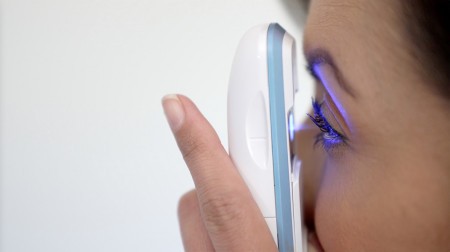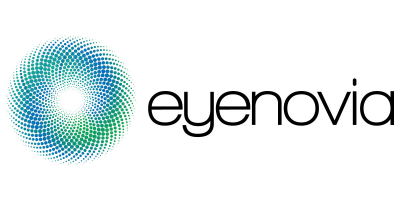Investigational Optejet® Microdose Dispenser from Eyenovia Shows Promise in Improving Treatment for Myopia, Presbyopia and Patients Getting Eye Exams

NEW YORK, October 17, 2022 (Newswire.com) - Two recent studies show that the novel Optejet® dispenser from Eyenovia, Inc., an ophthalmic pharmaceutical technology company, may be a more "human-centric" design than traditional eye droppers, which may make treatments for vision problems, including myopia, presbyopia and mydriasis, easier to deliver.
The investigational Optejet® dispenser administers ophthalmic solutions horizontally using the company's proprietary Microdose Array Print (MAP™) technology. The system has been shown to deliver accurate microdoses through a precision spray, dispensing medication with the push of a button, with no need to tilt the head back, and requires minimal hand-eye coordination.
Traditional eye drops can deliver four to five times larger volumes of medication than the human eye can hold, which can cause overdosing and drug waste. The Optejet® dispenser is designed to administer 1/5 the volume of solution compared to a traditional eyedropper, making doses less likely to spill or run onto the patient's face.
"Traditional eye drops typically overdose a patient's eye with medication and preservatives, which can lead to significant dose-related side effects," said Michael Rowe, CEO of Eyenovia. "Optejet® is proving to be easier to use and therefore may deliver the appropriate dose of medication to potentially decrease side effects."
One paper (Rathi, Scott, 2020) presented at the 2020 American Society of Cataract and Refractive Surgery reviewed multiple studies comparing the Optejet® dispenser with traditional eye droppers. In one study with the Optejet®, the researcher successfully administered 96% of doses on the first attempt, and 95% of patients successfully self-administered the doses on the first attempt as well. Another study found ophthalmic technicians successfully delivered doses on 83% of first attempts and were successful 99% of the time within two attempts.
A separate study conducted by Eyenovia (2021) monitored the six-month daily eye drop treatment compliance of 28 children ages 6 to 13 with pediatric progressive myopia. It found that nearly 90% of children using the Optejet® once-daily treatment successfully complied with their treatment regimen. This compares favorably to the 50% compliance rate for pediatric ophthalmic medications or the 59-69% range for adult topical ophthalmic drug users (Naito, 2018; see also Patel, 1995; Winfield, 1990; Matsui, 1997).
The unique delivery mechanism of the Optejet® has the potential to fundamentally change how people think about administering eye medication. Of 100 presbyopic patients between the ages of 40-55, four out of five said they would prefer using the investigational Optejet® device over traditional eye drops, according to a survey conducted by Eyenovia.
Optejet® has not been approved, cleared, or licensed by the U.S. Food and Drug Administration for use, and it is not commercially available in the United States. For more information about the Optejet® device, visit eyenovia.com.
About Eyenovia, Inc.
Eyenovia, Inc. is an ophthalmic pharmaceutical technology company developing a pipeline of microdose array print (MAPTM) therapeutics. Eyenovia is currently focused on the late-stage development of microdosed medications for mydriasis, presbyopia and myopia progression. For more information, visit www.eyenovia.com.
Forward-Looking Statements
Except for historical information, all of the statements, expectations and assumptions contained in this press release are forward-looking statements. Forward-looking statements include, but are not limited to, statements that express our intentions, beliefs, expectations, strategies, predictions or any other statements relating to our future activities or other future events or conditions, including estimated market opportunities for our product candidates and platform technology. These statements are based on current expectations, estimates and projections about our business based, in part, on assumptions made by management. These statements are not guarantees of future performance and involve risks, uncertainties and assumptions that are difficult to predict. Therefore, actual outcomes and results may, and in some cases are likely to, differ materially from what is expressed or forecasted in the forward-looking statements due to numerous factors discussed from time to time in documents which we file with the U.S. Securities and Exchange Commission. In addition, such statements could be affected by risks and uncertainties related to, among other things: risks of our clinical trials, including, but not limited to, the costs, design, initiation and enrollment (which could still be adversely impacted by COVID-19), timing, progress and results of such trials; the timing of, and our ability to submit applications for, obtaining and maintaining regulatory approvals for our product candidates; the potential impacts of COVID-19 on our supply chain; the potential advantages of our product candidates and platform technology; the rate and degree of market acceptance and clinical utility of our product candidates; our estimates regarding the potential market opportunity for our product candidates; reliance on third parties to develop and commercialize our product candidates; the ability of us and our partners to timely develop, implement and maintain manufacturing, commercialization and marketing capabilities and strategies for our product candidates; intellectual property risks; changes in legal, regulatory and legislative environments in the markets in which we operate and the impact of these changes on our ability to obtain regulatory approval for our products; and our competitive position. Any forward-looking statements speak only as of the date on which they are made, and except as may be required under applicable securities laws. Eyenovia does not undertake any obligation to update any forward-looking statements.
Source: Eyenovia
